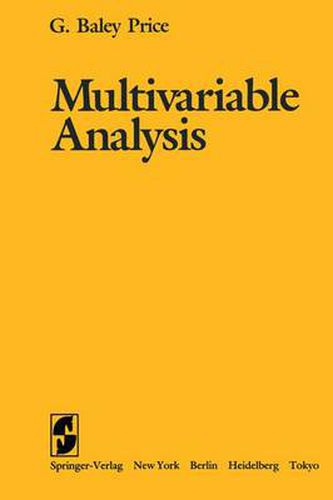Readings Newsletter
Become a Readings Member to make your shopping experience even easier.
Sign in or sign up for free!
You’re not far away from qualifying for FREE standard shipping within Australia
You’ve qualified for FREE standard shipping within Australia
The cart is loading…






This title is printed to order. This book may have been self-published. If so, we cannot guarantee the quality of the content. In the main most books will have gone through the editing process however some may not. We therefore suggest that you be aware of this before ordering this book. If in doubt check either the author or publisher’s details as we are unable to accept any returns unless they are faulty. Please contact us if you have any questions.
This book contains an introduction to the theory of functions, with emphasis on functions of several variables. The central topics are the differentiation and integration of such functions. Although many of the topics are familiar, the treatment is new; the book developed from a new approach to the theory of differentiation. Iff is a function of two real variables x and y, its deriva tives at a point Po can be approximated and found as follows. Let PI’ P2 be two points near Po such that Po, PI, P2 are not on a straight line. The linear function of x and y whose values at Po, PI’ P2 are equal to those off at these points approximates f near Po; determinants can be used to find an explicit representation of this linear function (think of the equation of the plane through three points in three-dimensional space). The (partial) derivatives of this linear function are approximations to the derivatives of f at Po ; each of these (partial) derivatives of the linear function is the ratio of two determinants. The derivatives off at Po are defined to be the limits of these ratios as PI and P2 approach Po (subject to an important regularity condition). This simple example is only the beginning, but it hints at a m theory of differentiation for functions which map sets in IRn into IR which is both general and powerful, and which reduces to the standard theory of differentiation in the one-dimensional case.
$9.00 standard shipping within Australia
FREE standard shipping within Australia for orders over $100.00
Express & International shipping calculated at checkout
This title is printed to order. This book may have been self-published. If so, we cannot guarantee the quality of the content. In the main most books will have gone through the editing process however some may not. We therefore suggest that you be aware of this before ordering this book. If in doubt check either the author or publisher’s details as we are unable to accept any returns unless they are faulty. Please contact us if you have any questions.
This book contains an introduction to the theory of functions, with emphasis on functions of several variables. The central topics are the differentiation and integration of such functions. Although many of the topics are familiar, the treatment is new; the book developed from a new approach to the theory of differentiation. Iff is a function of two real variables x and y, its deriva tives at a point Po can be approximated and found as follows. Let PI’ P2 be two points near Po such that Po, PI, P2 are not on a straight line. The linear function of x and y whose values at Po, PI’ P2 are equal to those off at these points approximates f near Po; determinants can be used to find an explicit representation of this linear function (think of the equation of the plane through three points in three-dimensional space). The (partial) derivatives of this linear function are approximations to the derivatives of f at Po ; each of these (partial) derivatives of the linear function is the ratio of two determinants. The derivatives off at Po are defined to be the limits of these ratios as PI and P2 approach Po (subject to an important regularity condition). This simple example is only the beginning, but it hints at a m theory of differentiation for functions which map sets in IRn into IR which is both general and powerful, and which reduces to the standard theory of differentiation in the one-dimensional case.